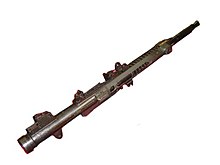This article needs additional citations for verification. (February 2022) |
| MG FF | |
|---|---|
 A restored MG FF cannon | |
| Type | Aircraft Cannon |
| Place of origin | Nazi Germany |
| Service history | |
| Wars | World War II |
| Production history | |
| Manufacturer | Ikaria |
| Specifications | |
| Mass | 26.3 kg (58 lb) |
| Length | 1,337 mm (52.6 in) |
| Barrel length | 822 mm (32.4 in) |
| Shell | 20×80mm RB |
| Caliber | 20 mm |
| Action | API blowback |
| Rate of fire | 520-540 rpm |
| Muzzle velocity | 585, 600 or 700 m/s |
| Feed system | Drum 30,45,60,90 rounds |
The MG FF was a drum-fed, blowback-operated, 20 mm aircraft autocannon, developed in 1936 by Ikaria Werke Berlin of Germany. It was a derivative of the Swiss Oerlikon FF F cannon (its FF suffix indicating Flügel Fest, for a fixed-mount, wing location from the Swiss original), with the Oerlikon FF design itself a development of the Imperial German World War I Becker 20 mm cannon, and was designed to be used in space-limited, fixed mountings such as inside aircraft wings, although it saw use as both an offensive and a defensive weapon, in both fixed and flexible format. It saw widespread use in those roles by the German Luftwaffe, particularly during the early stages of World War II, although from 1941 onwards it was gradually replaced by the Mauser firm's 20 mm MG 151/20, which had both a higher rate of fire and muzzle velocity.
One major disadvantage of the MG FF cannon was its extremely low ammunition count. One cannon only carried 90 bullets, and these were fired very quickly.